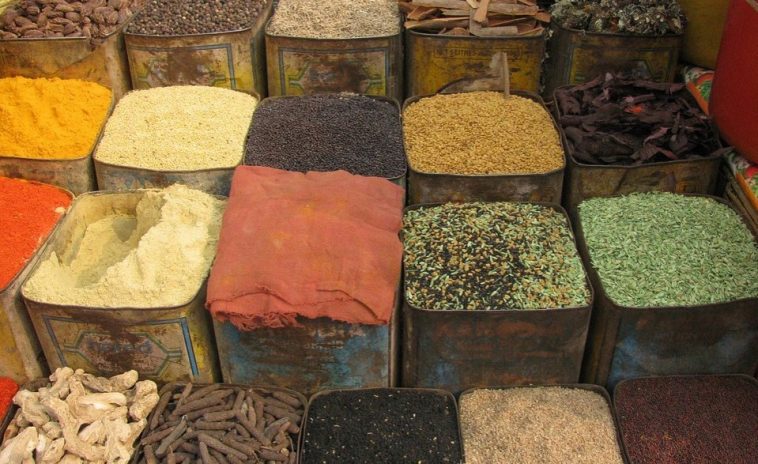A rare production system farmers delve into in sub-Saharan Africa is herb and spice production. This may be due to the lack of knowledge of their value, supply chain and market linkages, production techniques and a general trend to follow traditional farming production systems. Their exploitation ranging from the medical field to the cosmetic industry make them a low-hanging fruit that a vast number of farmers and agribusinesses could benefit from.
Spices can be defined as “vegetable products used for flavouring, seasoning and imparting aroma in foods” (FAO, 2005). Herbs are leafy spices, and some, like dill and coriander, can provide both spice seeds and leafy herbs.
Examples of spices are parsley, lavender, basil, mint, oregano, sage, rosemary, chives, French tarragon, marjoram, thyme, bay, fennel, lemon grass, lovage, anise, chervil, cumin, summer savoury, caraway, celery, garlic, lemon balm, dandelion, hibiscus flowers, lemon verbena, liquorice root, raspberry leaf, red clovers flowers, rosehips, stinging nettle, yarrow, calendula, chickweed, aloe, arnica, burdock, comfrey, plantain, St John’s wort, begarmot, bittersweet, orris root, patchouli, pine cones, rattlesnake master, scented geraniums, sumac, white sage, saffron, borage, chamomile, elderberry, hawthorn, evening primrose, milk thistle, alfalfa, bee balm, blue vervain, boneset, feverfew, gingko, heal all, heartsease, lemon verbena, mullein, round headed lespedeza, sheep sorrel, skullcap, stevia, black cohosh, Chinese milk vetch, echinacea, ginseng, and gold seal, among others.
Spices and herbs are grown as trees, shrubs, perennials, annuals, wild and cultivated. Spice and herb plants provide seeds and fruits, leaves and stems, flowers and buds, roots and rhizomes, bark and resins that can all be commercialised in various forms: sold fresh, frozen, dried, whole or ground, distilled into oils or solvent extracted into oleoresins.

The ten most popular African herbs and spices.
African seasoning and spice market projected growth
According to future market insights research, during the projected period, the global herb and spice extracts market is anticipated to thrive at an average CAGR of 5,1%. The market value is projected to increase from US$ 14,5 billion in 2022 to US$ 23,9 billion by 2032.
Demand for organic spices and herbs is being driven by increased interest in unusual flavours and growing healthcare consciousness among customers. Millennials are particularly interested in the many flavours and cuisine that reflect regional differences in culture.
Mordor Intelligence (2022) finds that the Africa spice and herb extracts market is consolidated, owing to the existence of few players holding majority of share in the market. Some of the key players in the market are Döhler GmbH, McCormick & Company, Inc, Kalsec Inc, Kerry Inc, and Olam International. Major players are opting for expansion strategies to expand their reach while focusing on producing purest and finest quality ingredients without any contaminations. They are investing in research and development activities to introduce ingredients in new flavours that are natural and safe for consumption. This, in turn, will increase sales of their ingredients among food and beverage companies in the region while garnering market dominance.

The common challenges faced by farmers in the herbs and spices value chain are the lack of networking arrangement between small-scale producers, and medium- and large-scale exporters/ producers; weak farmer organisation structures, especially in small-scale production, weak farmer organisation, unregistered groups; lack of suitable finance and credit facilities to farmers; inadequate good quality farm inputs; inadequate resources (financial and human resource) to support research and development of horticultural produce and low adoption of research outputs in support of horticultural development for export.
These challenges can be resolved through improving liaisons between the farmer and marketing associations, creating credit models that assist farmers begin spice and herb production at reasonable costs, solidification of unity among smallholder farmers for increased negotiating power with traders, and increased opportunities to build long-term relationships with buyers, and collaboration between the public and private sector in executing sustainable policy reforms to create an enabling environment for competitive production and marketing.
Improved training, promotion and investment into herb and spice production systems would spur not only growth of the African continents, culinary, medicinal, cosmetic, agricultural and textile industry through the raw products and value-added inventions, but would bring new technology, improve employment opportunities and permit even the smallholder farmer to participate in a global multibillion dollar playing field.
In the next articles of this series, we shall look into spice and herb production in Africa, and how it works. Keep an eye out, and be sure not to miss out on some informative content.

A plate of common herbs and spices.
References
Spices. Available at https://714493.smushcdn.com/1156533/wp-content/uploads/2020/09/herbsspices-1536×864.jpg?lossy=1&strip=1&webp=1
Matthews, M., Jack, M. (2011) Spices and herbs for home and market. Available at: https://www.fao.org/3/i2476e/i2476e00.pdf
Pratiksha Supekar, P. (2017) Available at https://quickasianrecipes.com/drying-of-fruits-and-vegetables/
Investment Opportunities in the Rwandan Herbs and Spices Sector TRAIDE Rwanda. (2020)
Herb & Spice Extracts Market Outlook (2022 – 2032) Available at: https://www.futuremarketinsights.com/reports/herb-and-spice-extracts-market#:~:text=Herb%20%26%20Spice%20Extracts%20Market%20Outlook%20(2022%20%2D%202032)&text=The%20market%20value%20is%20projected,US%24%2023.9%20Bn%20by%202032.
AFRICA SPICE AND HERB EXTRACTS MARKET – GROWTH, TRENDS, COVID-19 IMPACT, AND FORECASTS (2022 – 2027) (2022). Available at: https://www.mordorintelligence.com/industry-reports/africa-spice-and-herb-extracts-market
Mudau, F. N., Chimonyo, V. G. P., Modi, A. T., Mabhaudhi, T. Neglected and Underutilised Crops: A Systematic Review of Their Potential as Food and Herbal Medicinal Crops in South Africa. Available at: https://www.frontiersin.org/articles/10.3389/fphar.2021.809866/full









